ECON 202 Assignment 2: Creating a $100,000 Portfolio of Securities
VerifiedAdded on 2022/08/12
|7
|756
|32
Homework Assignment
AI Summary
This assignment, completed for ECON 202 at Coquitlam College, focuses on creating a $100,000 portfolio of securities. The student calculates holdings based on current market prices, providing details on selected financial instruments including stocks, bonds, real estate, and cash equivalents. The rationale behind instrument selection is discussed, emphasizing capital growth, cash flow, diversification, and liquidity objectives. A detailed analysis of how economic factors such as changes in interest rates, recessions, rapid inflation, and a depreciation of the Canadian dollar would affect the portfolio's value is also provided. The student's portfolio aims for capital growth and consistent income, considering long-term perspectives and diversification. The assignment also includes a bibliography of sources used.
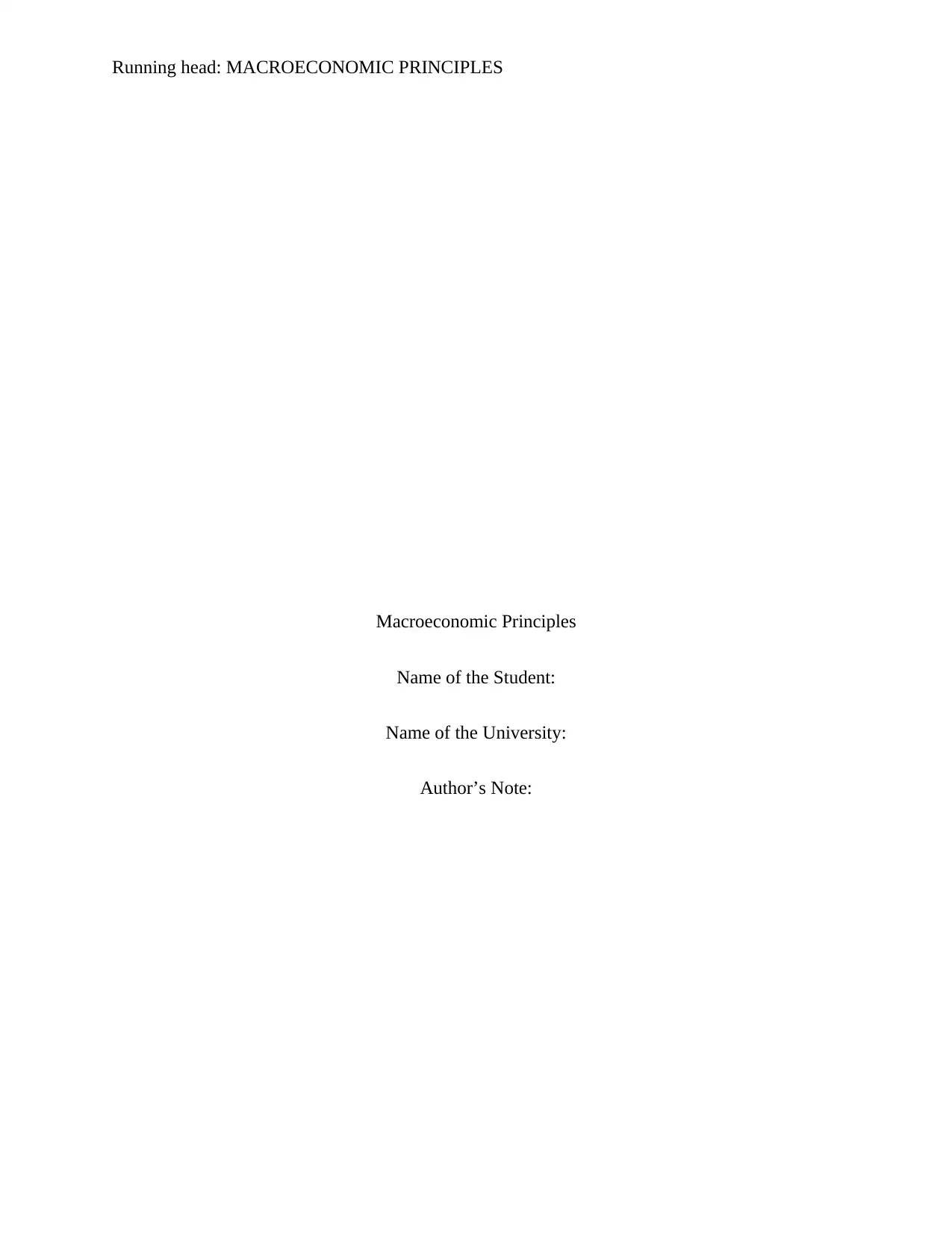
Running head: MACROECONOMIC PRINCIPLES
Macroeconomic Principles
Name of the Student:
Name of the University:
Author’s Note:
Macroeconomic Principles
Name of the Student:
Name of the University:
Author’s Note:
Paraphrase This Document
Need a fresh take? Get an instant paraphrase of this document with our AI Paraphraser
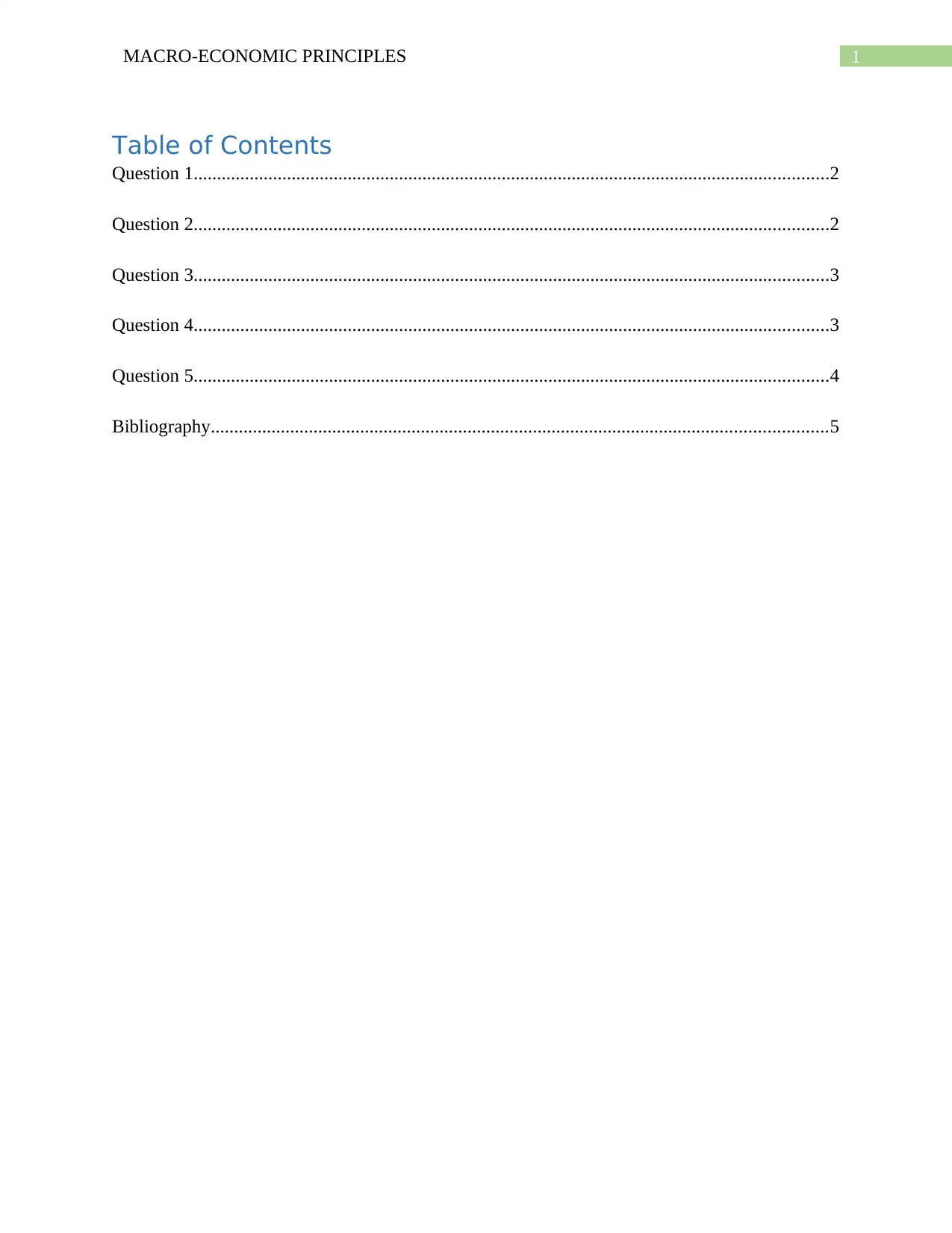
1MACRO-ECONOMIC PRINCIPLES
Table of Contents
Question 1........................................................................................................................................2
Question 2........................................................................................................................................2
Question 3........................................................................................................................................3
Question 4........................................................................................................................................3
Question 5........................................................................................................................................4
Bibliography....................................................................................................................................5
Table of Contents
Question 1........................................................................................................................................2
Question 2........................................................................................................................................2
Question 3........................................................................................................................................3
Question 4........................................................................................................................................3
Question 5........................................................................................................................................4
Bibliography....................................................................................................................................5

2MACRO-ECONOMIC PRINCIPLES
Question 1
The holding of each security based on the current market price are as follows:
Particulars Current Market Price No. of Securities Amount ($) Weight (%)
Stocks 50,000 50%
Brookfield Asset Management (BAM) 62.03 403.03 25,000
Enbridge Incorporated (ENB) 38.07 656.69 25,000
Bonds 30,000 30%
Christus Health Revenue and Refunding 114.98 260.91 30,000
Real Estate (REIT ETF) 15,000 15%
Vanguard Real Estate ETF (VNQ) 94.57 79.31 7,500
Schwab U.S. REIT ETF (SCHH) 45.23 165.82 7,500
Cash and Cash Equivalents 5,000 5%
Risk Free Rate (10 Year US Government Bond) 5000 1.00 5,000
Total Amount ($) 100,000
Portfolio Investment Overview
Question 2
Company Name Origin
Stocks
Brookfield Asset Management (BAM) United States
Enbridge Incorporated (ENB) United States
Bonds
Christus Health Revenue and Refunding United States
Real Estate (REIT ETF)
Vanguard Real Estate ETF (VNQ) United States
Schwab U.S. REIT ETF (SCHH) United States
Cash and Cash Equivalents
Risk Free Rate (10 Year US Government Bond) United States
Total Amount ($)
Financial Instruments Details
Question 1
The holding of each security based on the current market price are as follows:
Particulars Current Market Price No. of Securities Amount ($) Weight (%)
Stocks 50,000 50%
Brookfield Asset Management (BAM) 62.03 403.03 25,000
Enbridge Incorporated (ENB) 38.07 656.69 25,000
Bonds 30,000 30%
Christus Health Revenue and Refunding 114.98 260.91 30,000
Real Estate (REIT ETF) 15,000 15%
Vanguard Real Estate ETF (VNQ) 94.57 79.31 7,500
Schwab U.S. REIT ETF (SCHH) 45.23 165.82 7,500
Cash and Cash Equivalents 5,000 5%
Risk Free Rate (10 Year US Government Bond) 5000 1.00 5,000
Total Amount ($) 100,000
Portfolio Investment Overview
Question 2
Company Name Origin
Stocks
Brookfield Asset Management (BAM) United States
Enbridge Incorporated (ENB) United States
Bonds
Christus Health Revenue and Refunding United States
Real Estate (REIT ETF)
Vanguard Real Estate ETF (VNQ) United States
Schwab U.S. REIT ETF (SCHH) United States
Cash and Cash Equivalents
Risk Free Rate (10 Year US Government Bond) United States
Total Amount ($)
Financial Instruments Details
⊘ This is a preview!⊘
Do you want full access?
Subscribe today to unlock all pages.

Trusted by 1+ million students worldwide
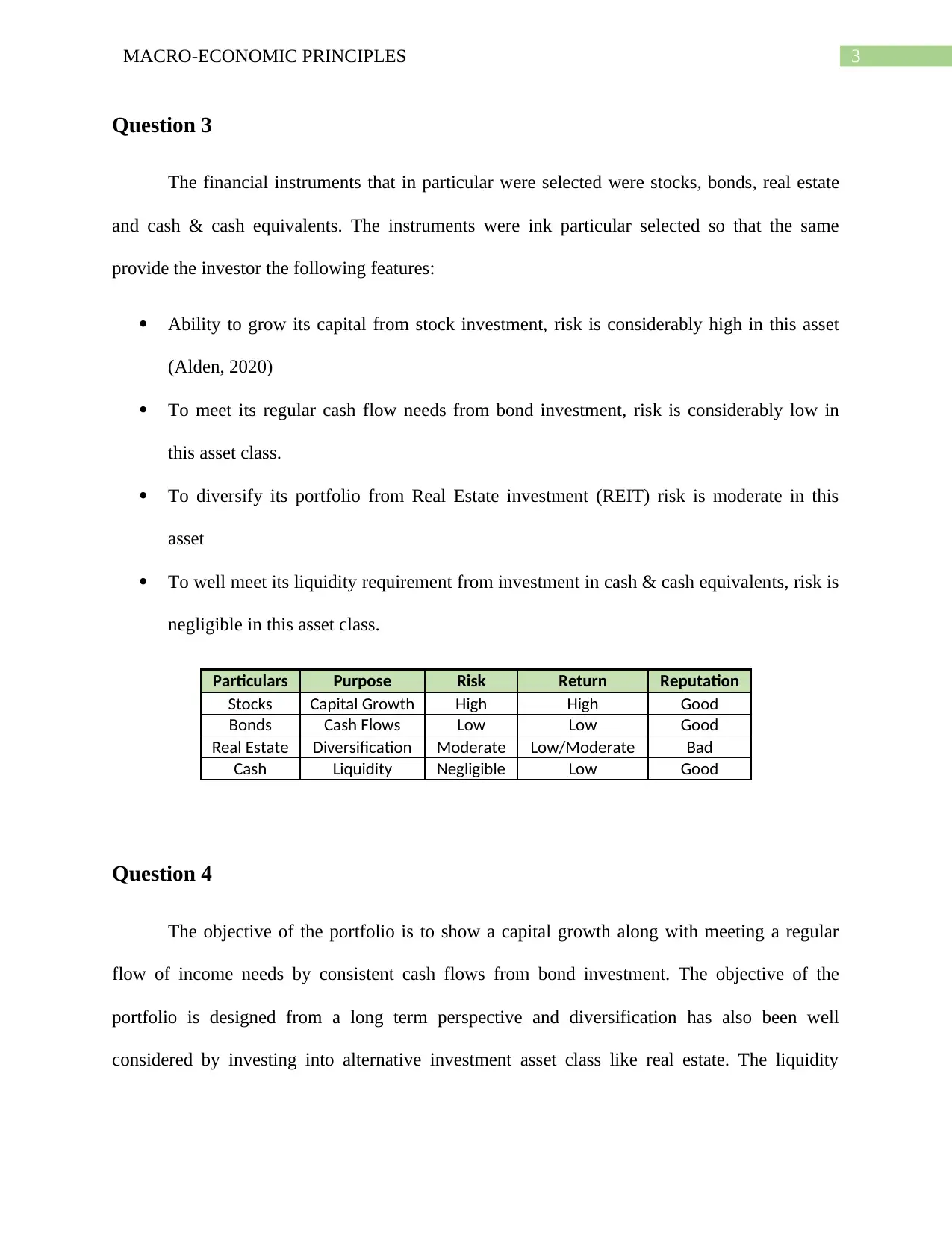
3MACRO-ECONOMIC PRINCIPLES
Question 3
The financial instruments that in particular were selected were stocks, bonds, real estate
and cash & cash equivalents. The instruments were ink particular selected so that the same
provide the investor the following features:
Ability to grow its capital from stock investment, risk is considerably high in this asset
(Alden, 2020)
To meet its regular cash flow needs from bond investment, risk is considerably low in
this asset class.
To diversify its portfolio from Real Estate investment (REIT) risk is moderate in this
asset
To well meet its liquidity requirement from investment in cash & cash equivalents, risk is
negligible in this asset class.
Particulars Purpose Risk Return Reputation
Stocks Capital Growth High High Good
Bonds Cash Flows Low Low Good
Real Estate Diversification Moderate Low/Moderate Bad
Cash Liquidity Negligible Low Good
Question 4
The objective of the portfolio is to show a capital growth along with meeting a regular
flow of income needs by consistent cash flows from bond investment. The objective of the
portfolio is designed from a long term perspective and diversification has also been well
considered by investing into alternative investment asset class like real estate. The liquidity
Question 3
The financial instruments that in particular were selected were stocks, bonds, real estate
and cash & cash equivalents. The instruments were ink particular selected so that the same
provide the investor the following features:
Ability to grow its capital from stock investment, risk is considerably high in this asset
(Alden, 2020)
To meet its regular cash flow needs from bond investment, risk is considerably low in
this asset class.
To diversify its portfolio from Real Estate investment (REIT) risk is moderate in this
asset
To well meet its liquidity requirement from investment in cash & cash equivalents, risk is
negligible in this asset class.
Particulars Purpose Risk Return Reputation
Stocks Capital Growth High High Good
Bonds Cash Flows Low Low Good
Real Estate Diversification Moderate Low/Moderate Bad
Cash Liquidity Negligible Low Good
Question 4
The objective of the portfolio is to show a capital growth along with meeting a regular
flow of income needs by consistent cash flows from bond investment. The objective of the
portfolio is designed from a long term perspective and diversification has also been well
considered by investing into alternative investment asset class like real estate. The liquidity
Paraphrase This Document
Need a fresh take? Get an instant paraphrase of this document with our AI Paraphraser
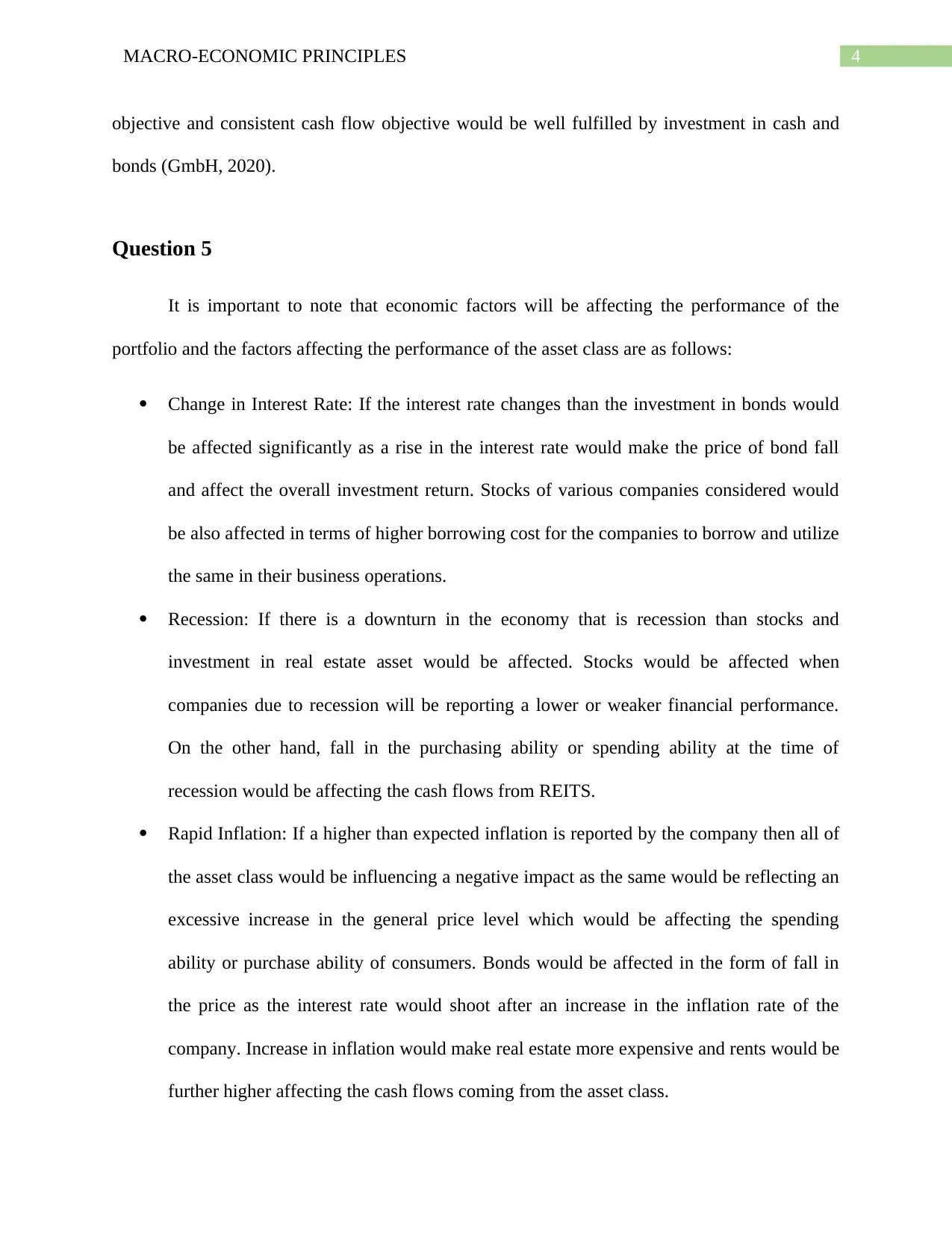
4MACRO-ECONOMIC PRINCIPLES
objective and consistent cash flow objective would be well fulfilled by investment in cash and
bonds (GmbH, 2020).
Question 5
It is important to note that economic factors will be affecting the performance of the
portfolio and the factors affecting the performance of the asset class are as follows:
Change in Interest Rate: If the interest rate changes than the investment in bonds would
be affected significantly as a rise in the interest rate would make the price of bond fall
and affect the overall investment return. Stocks of various companies considered would
be also affected in terms of higher borrowing cost for the companies to borrow and utilize
the same in their business operations.
Recession: If there is a downturn in the economy that is recession than stocks and
investment in real estate asset would be affected. Stocks would be affected when
companies due to recession will be reporting a lower or weaker financial performance.
On the other hand, fall in the purchasing ability or spending ability at the time of
recession would be affecting the cash flows from REITS.
Rapid Inflation: If a higher than expected inflation is reported by the company then all of
the asset class would be influencing a negative impact as the same would be reflecting an
excessive increase in the general price level which would be affecting the spending
ability or purchase ability of consumers. Bonds would be affected in the form of fall in
the price as the interest rate would shoot after an increase in the inflation rate of the
company. Increase in inflation would make real estate more expensive and rents would be
further higher affecting the cash flows coming from the asset class.
objective and consistent cash flow objective would be well fulfilled by investment in cash and
bonds (GmbH, 2020).
Question 5
It is important to note that economic factors will be affecting the performance of the
portfolio and the factors affecting the performance of the asset class are as follows:
Change in Interest Rate: If the interest rate changes than the investment in bonds would
be affected significantly as a rise in the interest rate would make the price of bond fall
and affect the overall investment return. Stocks of various companies considered would
be also affected in terms of higher borrowing cost for the companies to borrow and utilize
the same in their business operations.
Recession: If there is a downturn in the economy that is recession than stocks and
investment in real estate asset would be affected. Stocks would be affected when
companies due to recession will be reporting a lower or weaker financial performance.
On the other hand, fall in the purchasing ability or spending ability at the time of
recession would be affecting the cash flows from REITS.
Rapid Inflation: If a higher than expected inflation is reported by the company then all of
the asset class would be influencing a negative impact as the same would be reflecting an
excessive increase in the general price level which would be affecting the spending
ability or purchase ability of consumers. Bonds would be affected in the form of fall in
the price as the interest rate would shoot after an increase in the inflation rate of the
company. Increase in inflation would make real estate more expensive and rents would be
further higher affecting the cash flows coming from the asset class.

5MACRO-ECONOMIC PRINCIPLES
Decrease in CAD Dollar: A decrease in CAD Dollar can in particular affect the stocks as
an asset class as the considered BAM Stock is based in Canada and fluctuation in the
CAD dollar can affect the operations and cash flows of the company.
Decrease in CAD Dollar: A decrease in CAD Dollar can in particular affect the stocks as
an asset class as the considered BAM Stock is based in Canada and fluctuation in the
CAD dollar can affect the operations and cash flows of the company.
⊘ This is a preview!⊘
Do you want full access?
Subscribe today to unlock all pages.

Trusted by 1+ million students worldwide
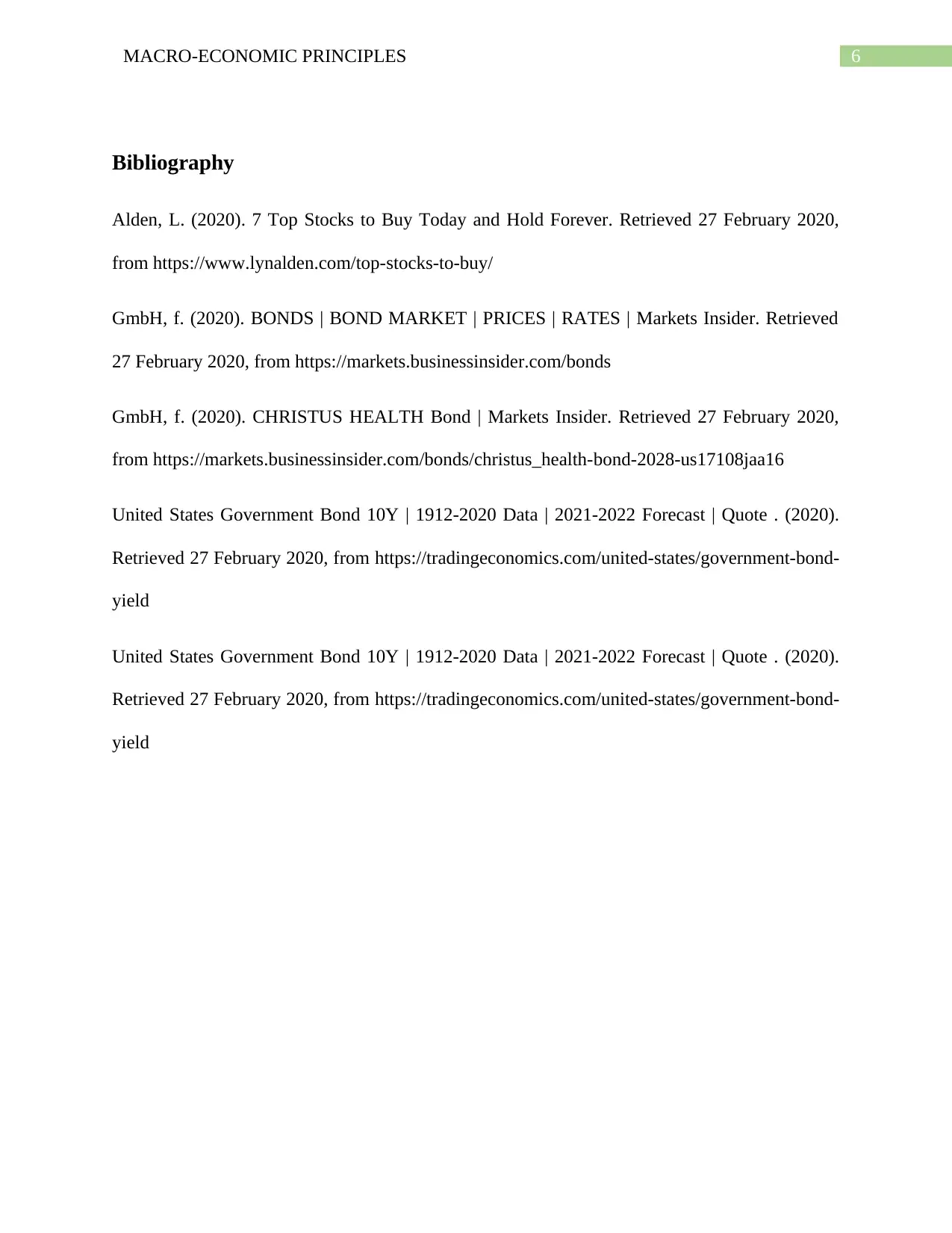
6MACRO-ECONOMIC PRINCIPLES
Bibliography
Alden, L. (2020). 7 Top Stocks to Buy Today and Hold Forever. Retrieved 27 February 2020,
from https://www.lynalden.com/top-stocks-to-buy/
GmbH, f. (2020). BONDS | BOND MARKET | PRICES | RATES | Markets Insider. Retrieved
27 February 2020, from https://markets.businessinsider.com/bonds
GmbH, f. (2020). CHRISTUS HEALTH Bond | Markets Insider. Retrieved 27 February 2020,
from https://markets.businessinsider.com/bonds/christus_health-bond-2028-us17108jaa16
United States Government Bond 10Y | 1912-2020 Data | 2021-2022 Forecast | Quote . (2020).
Retrieved 27 February 2020, from https://tradingeconomics.com/united-states/government-bond-
yield
United States Government Bond 10Y | 1912-2020 Data | 2021-2022 Forecast | Quote . (2020).
Retrieved 27 February 2020, from https://tradingeconomics.com/united-states/government-bond-
yield
Bibliography
Alden, L. (2020). 7 Top Stocks to Buy Today and Hold Forever. Retrieved 27 February 2020,
from https://www.lynalden.com/top-stocks-to-buy/
GmbH, f. (2020). BONDS | BOND MARKET | PRICES | RATES | Markets Insider. Retrieved
27 February 2020, from https://markets.businessinsider.com/bonds
GmbH, f. (2020). CHRISTUS HEALTH Bond | Markets Insider. Retrieved 27 February 2020,
from https://markets.businessinsider.com/bonds/christus_health-bond-2028-us17108jaa16
United States Government Bond 10Y | 1912-2020 Data | 2021-2022 Forecast | Quote . (2020).
Retrieved 27 February 2020, from https://tradingeconomics.com/united-states/government-bond-
yield
United States Government Bond 10Y | 1912-2020 Data | 2021-2022 Forecast | Quote . (2020).
Retrieved 27 February 2020, from https://tradingeconomics.com/united-states/government-bond-
yield
1 out of 7
Related Documents
Your All-in-One AI-Powered Toolkit for Academic Success.
+13062052269
info@desklib.com
Available 24*7 on WhatsApp / Email
![[object Object]](/_next/static/media/star-bottom.7253800d.svg)
Unlock your academic potential
Copyright © 2020–2025 A2Z Services. All Rights Reserved. Developed and managed by ZUCOL.




